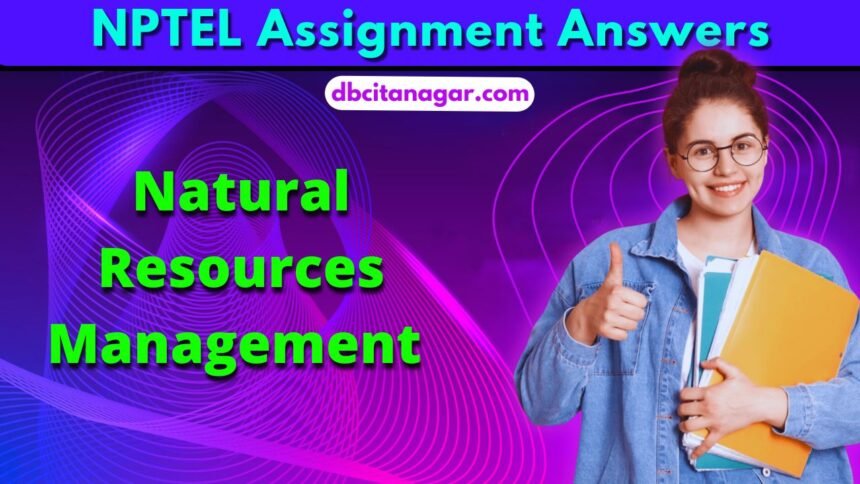NPTEL Natural Resources Management Week 5 Assignment Answers 2024
1. What is the primary purpose of cloud seeding in drought management?
a) To prevent rain from falling in drought-prone areas
b) To enhance the natural precipitation process in rain clouds
c) To create artificial clouds
d) To disperse pollutants in the atmosphere
Answer :- For Answers Click Here
2. How long does it typically take for rainfall to occur after cloud seeding?
a) Immediately
b) 5-10 minutes
c) 15-20 minutes
d) 30-40 minutes
Answer :- For Answers Click Here
3. What is the primary challenge associated with excluding individuals from using common property resources (CPRs)?
a) Legal barriers
b) High administrative costs
c) Physical barriers
d) Technological limitations
Answer :- For Answers Click Here
4. Which of the following is a potential disadvantage of common property rights (CPRs)?
a) Reduced administrative costs
b) Enhanced community cooperation
c) Tendency of overexploitation of resources
d) Improved sustainable resource management
Answer :-
5. Which international standard specifies the requirements for an Environmental Management System (EMS)?
a) ISO 9001
b) ISO 45001
c) ISO 14001
d) ISO 22000
Answer :-
6. Why is the concept of Environmental Management Systems (EMS) particularly significant for developing countries?
a) Because they have surplus financial resources
b) Because they face greater environmental risks due to industrialization and developmental projects
c) Because they have advanced environmental regulations
d) Because they do not need to worry about environmental impacts
Answer :- For Answers Click Here
7. Which of the following is NOT a benefit of implementing an EMS?
a) Improved environmental performance
b) Increased operating costs
c) Enhanced employee morale
d) Enhanced image with public and regulators
Answer :-
8. Which of the following principles of NEP states that “the right to development must be fulfilled to equitably meet developmental and environmental needs of present and future generations”?
a) Equity
b) The Precautionary Approach
c) The Right to Development
d) Environmental Protection
Answer :-
9. Which of the following principles requires that the services of environmental resources be given economic value?
a) Public Trust Doctrine
b) Economic Efficiency
c) Decentralization
d) Preventive Action
Answer :-
10. The National Environment Policy (NEP) was initiated by which ministry in India?
a) Ministry of Agriculture
b) Ministry of Environment and Forests
c) Ministry of Rural Development
d) Ministry of Health and Family Welfare
Answer :- For Answers Click Here
11. What factors contribute to the successful implementation of common property regimes? (Select all that apply)
a) High-cost monitoring and sanctioning arrangements
b) Stability and longevity of the resource-using group
c) Exclusion of external participants
d) Effective collective-choice rules
Answer :-
12. Which activities are involved in the Do phase of the ISO 14001 PDCA model? (Select all that apply)
a) Competence, training, and awareness
b) Monitor and measure
c) Control of documents
d) Management review
Answer :-
13. Assertion (A): An Environmental Management System (EMS) helps organizations achieve their environmental goals through consistent review, evaluation, and improvement of environmental performance.
Reason (R): ISO 14001 specifies requirements for environmental management systems, following the plan-do-check-act (PDCA) model.
a) Both A and R are true, and R is the correct explanation of A.
b) Both A and R are true, but R is not the correct explanation of A.
c) A is true, but R is false.
d) A is false, but R is true.
Answer :- For Answers Click Here
14. Assertion (A): The Plan-Do-Check-Act (PDCA) model is an iterative process applied regularly in Environmental Management Systems (EMS) to ensure benefits and standard compliance.
Reason (R): The PDCA model emphasizes emergency responses to environmental crises over continuous improvement.
a) Both A and R are true, and R is the correct explanation of A.
b) Both A and R are true, but R is not the correct explanation of A.
c) A is true, but R is false.
d) A is false, but R is true.
Answer :-
15. The principle of “Legal Liability” in NEP follows which approach to deter environmentally harmful actions and compensate victims?
a) Polluter Pays
b) Precautionary Principle
c) Preventive Action
d) Public Trust Doctrine
Answer :- For Answers Click Here

![NPTEL Problem Solving Through Programming in C Week 5 Assignment Answers 2025 2 [Week 1] NPTEL Problem Solving Through Programming In C Assignment Answers 2023](https://dbcitanagar.com/wp-content/uploads/Nptel-Problem-Solving-Through-Programming-In-C-Answer-150x150.png)



